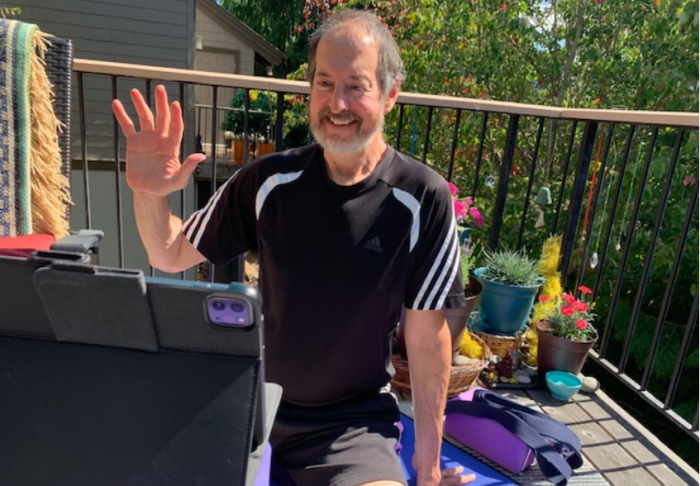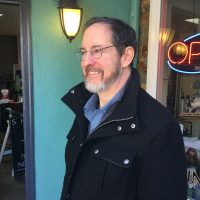A silver lining in the pandemic for me is membership in a Zoom-supported yoga sanctuary.
This sanctuary is a place where about a dozen yoga practitioners come together twice each week to learn, practice, and connect with each other in a virtual yoga community. Developed and led by a gifted yoga teacher, Leslie Ellis, the sanctuary began in early spring 2020 and continues to go strong.
I’d like to share several lessons I’m learning about participating in a yoga community from my sanctuary experience. The article is intended for anybody who might be thinking about joining or organizing a yoga community and perhaps other communities as well.
Belonging in Community is As Much about Mutual Caring as about Doing Things Together
My fellow sanctuary members and I joined the sanctuary to do yoga with a teacher we trust and to practice yoga with other students, even if remotely. Our tie prior to the sanctuary was to yoga and to our teacher, but not to each other.
I approached the sanctuary without a clear picture of a yoga community. I tended to use the words “group” and “community” interchangeably. If a bunch of us yoga practitioners were all doing yoga together with the same teacher, I initially told myself, then we would be acting as a yoga community.
But as the opening of the sanctuary drew close, I sensed a longing in me for something more than a class. Perhaps this longing reflected the general isolation that so many of us were experiencing during the pandemic.
What I was looking for in the yoga sanctuary was not simply an additional opportunity to study and practice yoga. I was looking for a place to belong—to feel welcome, seen, and accepted for who I was and, reciprocally, to extend an open hand and heart to others. I wanted this place of belonging to be framed by a common commitment to yoga. But I wanted it also to be a place where we could come to know and care about each other as people.
A month or two into the sanctuary, I discovered a wonderful book called The Art of Community by Charles Vogl. Vogl defined community as “…a group of individuals who share a mutual concern for one another’s welfare. It’s distinct from a group whose members may share ideas, interests, proximity, or any number of things but lack concern for one another.”
Vogl had put his finger on what I was seeking in the sanctuary: committed yoga practitioners who care about each other’s well-being.
Well-designed Structures of Caring seem Necessary for a Yoga Group to Develop into a Community
Let me describe the structure of caring that is built into the sanctuary, because well-designed structures are scaffolds for community.
Holding Space
Holding space is about deep listening, so the person you are listening to feels heard and seen without risk of being judged. In this practice, you rely on your intentions, posture, body language, and breathing rhythms to welcome in the other’s experience: “How Yoga Helped Me to Hold Space for Another.” But you resist the urge to comment, question, advise, or even compliment the other. Perhaps paradoxically, the silence that greets a person’s disclosures in the holding space ritual can foster a closer bond than when the listener responds actively and vocally.
In the sanctuary, we take turns holding space for each other on Wednesday afternoons in the context of an hour-long meditation-centered session. Leslie opens break-out rooms on Zoom so we can hold space in pairs and sometimes in trios.
Holding space is harder than it might seem at first glance, because to really make room for another’s experience, you have to get over yourself. My tendency is to relate a friend’s stories to my own, as if what they are saying matters to the extent that I can find something similar in my experience. But this searching for commonality, which surely has its place, is not what holding space is about.
For example, during the first few weeks of the sanctuary, I was holding space for a fellow member as she shared something painful in the life of her family. Before I knew it, memories from a time when my family was struggling came flooding in. I got caught up with my own past drama and left my friend’s narrative behind.
What helped me to be more present with my friend’s experience and less absorbed by my own was to find ease and steadiness in the breath. Settling into my breath and body, rather than flying away in my mind, allowed me to open more space for my friend’s inner reality.
A Private Facebook Group
Before the sanctuary, I had a Facebook account but rarely used it. I harbored a superior attitude toward this platform because it seemed to promote superficial and image-conscious messaging. Somewhat snottily, I saw myself as being deeper than the typical Facebook user.
But Leslie created a private Facebook group for members of our sanctuary, and in this space, the messages are not shallow. They convey our self-reflections on meditation and asana sessions and their implications for our lives more generally.
For example, a fellow sanctuary member posted a message about her letting go of a need for the one just-right yoga “lineage.” She was moving beyond the search for a pre-established yoga worldview. The teaching and support of the sanctuary, she reported, helped her to embrace more mystery in her yoga practice and find her own way.
I found this message inspirational and appreciated the chance to tell her so in the private Facebook group.
Personal Encouragement to Participate Can Make a Big Difference
At one point in the sanctuary, I became self-conscious about my participation pattern. I grew concerned that I had been writing longer Facebook posts than any other member and was also writing more frequently than many. Further, at the end of our asana sessions, I commented more regularly than others.
I feared I was taking up too much space. Was I crowding out fellow members who might otherwise have contributed more?
So, I stopped writing in the Facebook group and stopped commenting after asana practice.
Leslie noticed. She asked me in a phone conversation if something was wrong.
She offered her observation that I was neither writing nor speaking too much or too often. She encouraged me to re-emerge, to bring back my full self.
Leslie’s reaching out made a difference. I took her advice and since then have been comfortable participating in a way that is natural to me.
I don’t know whether my experience would generalize to other communities. But intuitively, I sense that when a member seems reluctant to express themselves, a personal outreach from a community convener, elder, or peer might be just the thing to inspire the member to step more fully into the circle of belonging.
In conclusion, I would affirm my hopefulness about yoga communities. With meaningful structures of caring, such as holding space rituals and private Facebook groups, and with personal encouragement to participate, a yoga community can be a place of belonging, growth, and mutual care.
~











Read 4 comments and reply